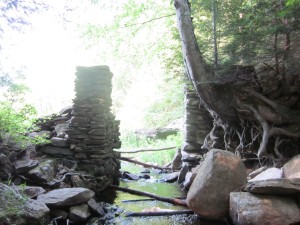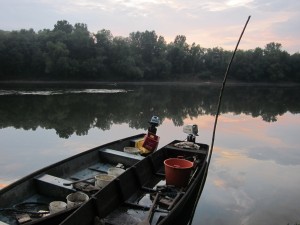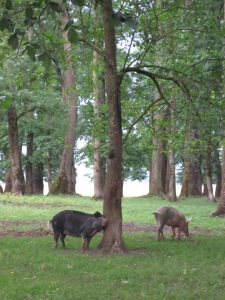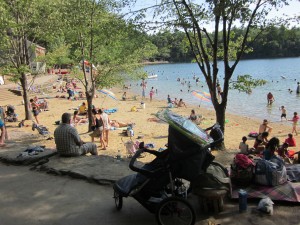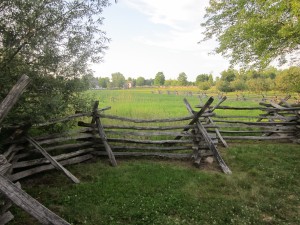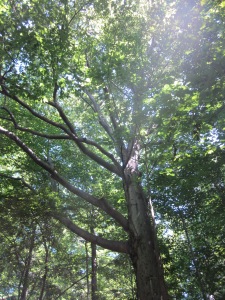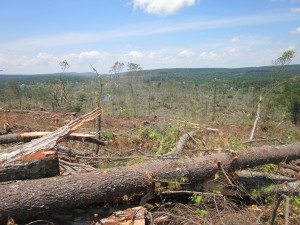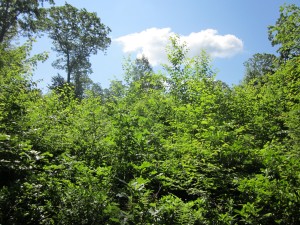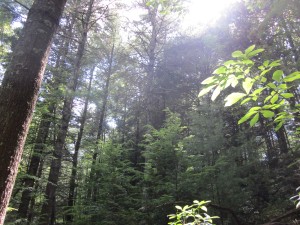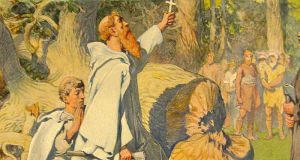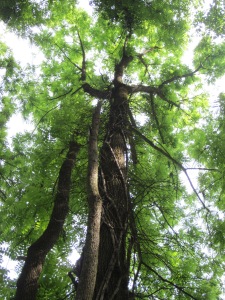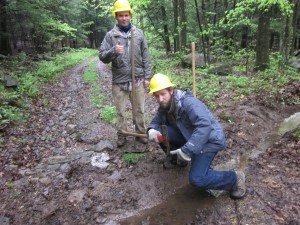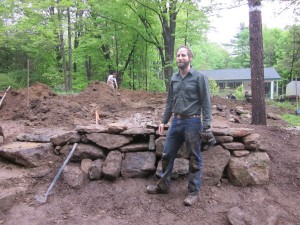Category Archives: Forestry
Sacred Groves
Posted by on August 13, 2011
6-Consecration
After my visit to Walden Pond, I felt I had more questions than answers. So a few days after my Walden adventure, when my apprentice duties were done for the day, I went for a walk alone. From camp I headed north on a small dirt logging road with no particular destination. Turning off the main path I came across the wreckage of an old mill whose stone ramparts still flanked a gurgling stream. Beyond the narrow stream was the old holding pond, where earthen dams on either side gathered the stream’s water. The water then flowed over the mill’s wheel. The pool was now a large pond filled with fish, lily pads and riparian plants. These mills are common in New England and were used to power sawmills, grind grain and corn, and even generate electricity in later years. It had been out of commission for some time, but there were still large rusty gears strewn about the stream. Second growth forest, which had recovered beautifully, grew up through the stones. I scrambled along the south side of the stream looking down at where the gears had once crossed. The stone walls were still neatly stacked. Birds chirped nearby, and a pair of bumble bees buzzed in and out of their home in the rocks. Mosquitoes bounced off the black pools of water below occasionally gulped down by the tiny bass and blue gill that populated the stream and pond. The sun was beginning to set, winking at me through wavery bows of hemlock, black birch and sugar maple.
I sat cross legged on atop the large stone wall and took a deep breath. I started the summer asking a simple question: Can forests be sacred without the separation of culture and nature? I throw a pebble from my rock perch down to the dark water. To make sacred must somehow become an activity not of separation and delineation, but one of unification and integration. But to declare the forest sacred and dust off my hands doesn’t accomplish anything. There is process here. The rings from my pebbles expand outward and envelop the length and breadth of a small trickling pool. To make sacred…consecration…holy…hallowed. I return to the word consecration in my mind, and throw another pebble.
The word will be familiar to most Mormon readers. Ordinarily, to consecrate means to make something or someplace sacred, to set apart, or to dedicate oneself to something. We consecrate a temple, or our actions to God. But the prefix con- means with, jointly, together. What would it mean to interpret consecration as meaning to make sacred with? Why not? Rather than declaring certain spaces as inherently sacred in opposition to places that are not, consecration could come to represent the process of being in a special kind of religious relationship with each other and the earth. Salvation or eternal progression means moving toward perfection, wholeness; but as Mormons we do not believe that we do this alone. Mormon theology affirms that the eternities will be spent with our families, creation and the earth. Our temples are devoted to creating webs of relationship that are believed to endure throughout eternity. Our early communalist social organization was devoted to fostering a celestial economy free of competition and worthy of the angels. Even today’s Mormon congregations and other spiritual communities are places we go to learn, improve ourselves and serve one another—what Mormons call ‘perfecting the saints.’ Perfection is not an achievement it is a process.
However, consecration as an ecological relationship has not been explored by Mormon theologians. To convince ourselves that to make sacred with is an eternal process, emphasizing the immanence of God seems like an important preliminary step. While Christianity has in many of its larger strains emphasized the transcendence of God, there are many lesser known pan-theistic and pan-en-theistic strains of Christianity that focus on immanence. The distinction is subtle but important; for the pantheist, God is synonymous with the universe i.e God=everything. While critics have struggled with why this is any different from atheism, pantheists like Michael P. Levine insist that pantheism asserts a single divine reality. Panentheism on the other hand asserts that God is both transcendent and immanent; God retains a separation from creation, but also dwells within it. Sally Mcfague’s book The Body of God is an excellent example of a successful articulation of a Christian panentheist theology. The world (i.e. everything that exists) is God’s body, a body in which his spirit dwells.
Mormon theology, as usual, holds a curious middle ground in the discussion between transcendence and immanence. Starting with Joseph Smith’s assertion that God exists within the universe, most Mormon theologians would insist that references to God’s body is no metaphor. So while God is within time and space, s/he is separated by his/her corporeal form from the rest of creation. Yet in the doctrine of the ‘Light of Christ’ we get a sense of how God’s immanence might work within Mormon ecotheology.
“He that ascended up on high, as also he descended below all things, in that he comprehended all things, that he might be in all and through all things, the light of truth; Which truth shineth. This is the light of Christ. As also he is in the sun, and the light of the sun, and the power thereof by which it was made. As also he is in the moon, and is the light of the moon, and the power thereof by which it was made; As also the light of the stars, and the power thereof by which they were made; And the earth also, and the power thereof, even the earth upon which you stand. And the light which shineth, which giveth you light, is through him who enlighteneth your eyes, which is the same light that quickeneth your understandings; Which light proceedeth forth from the presence of God to fill the immensity of space—The light which is in all things, which giveth life to all things, which is the law by which all things are governed, even the power of God who sitteth upon his throne, who is in the bosom of eternity, who is in the midst of all things” (D & C 88:6-13).
The light of Christ dwells in all things but is also likened unto the power by which all things were made. The emphasis on heavenly bodies gives this dwelling a deeply cosmological focus. God is thus immanent in the process of consecration not only through his/her desire for us to be like them, but through the Light of Christ whose immanence draws us toward the good. Another aspect of consecration is related to Mormonism’s unique theology of intelligence(s). “Man was also in the beginning with God. Intelligence, or the light of truth, was not created or made neither indeed can be” (D&C 93:29). For Smith spirit is material, and all spirit-matter is imbued with intelligence, i.e. that power by which it was made. Abraham 3:22 provides a slightly different concept of intelligences—less a quality of matter than a pre-mortal characteristic: “Now the Lord had shown unto me, Abraham, the intelligences that were organized before the world was; and among all these there were many of the noble and great ones.” Intelligence in both cases clearly point to the basic units of the pre-mortal soul. Mormon theologian, philosopher and Apostle Orson Pratt took this idea a step further:
“All the organizations of worlds, of minerals, of vegetables, of animals, of men, of angels, of spirits, and of the spiritual personages of the Father, of the Son, and the Holy Ghost, must, if organized at all, have been the result of the self-combinations and unions of the preexistent, intelligent, powerful, and eternal particles of substance. These eternal Forces and Powers are the Great First Causes of all things and events that have had a beginning.”[1]
Pratt takes Smith’s intelligences in the direction of self-organizing intelligence-matter as the basic unit of cosmological creativity, out of which the myriad forms of the organized universe emerge. Brigham Young also took a radical view of matter when he said:
“There is not one particle of element, which is not filled with life. . . . There is life in all matter, throughout the vast extent of all the eternities; it is in the rock, the sand, the dust, in water, and gasses, and in short, in every description and organization of matter whether it be solid, liquid, or gaseous, particle operating within particle.”[2]
These teachings also harmonize with the creation stories found in Joseph Smith’s Moses 3 in which animals and plants are created as living souls, rather than living creatures as translated in the King James. Enoch also encounters the earth as a living breathing and lamenting living soul in Moses 7. These unique Mormon teachings, give us a glimpse of the importance of embodiment in Joseph’s theology. The idea that all matter is pervaded with active intelligence democratizes the substance of the universe and challenges traditional dualisms of spirit and body, even within God themselves. As Sally Mcfague frames embodiment, it is “[t]hrough our bodies, in their agonies and ecstasies that lie behind and beyond all linguistic expression, [that] we are bound into a network of relations with our natural environment and experience ourselves as bodies with other bodies. Whatever else experience means, it includes bodily experience as a primordial reality, uniting us in ever-widening concentric circles with the entire planet in all its diverse, rich forms of embodiment.”[3]
Existence is embodiment, embodiment is being in relationship, salvation is a process bound by relationships and the goal of that process is consecration—to make all bodies sacred. Thomas Berry believes that in order to authentically participate in this process we must get serious about “fostering mutually enhancing relationships with the earth;” relationships that are not exploitative but mutually beneficial for humans and the earth we rely on; relationships that do not treat humans and nature as separate entities but as a network of embodied creatures moving through the cosmos together. Industrial civilization has long emphasized an extractive and exploitative relationship, the Light of Christ compels us toward something entirely different.
Consecrating the Forests
Ok, so how does this apply to forestry? Stay with me! The best example of how consecration could work ecologically, besides the work I have been doing this summer, comes from a national park in Croatia—one of our stops during my trip to Europe this spring.
Lonjsko Polje is a national park in central Croatia which encompasses much of the Sava River basin, a tributary to the Danube. The park is run by a charismatic man named Goran Gugić who spent the day with us, explaining the complex cultural and ecological landscape. Many rural and marginal places, according to Gugić, have developed what he calls “organically evolved cultural landscapes.” By this he means that throughout the almost 2,000 years that humans have occupied this dynamic ecosystem, they have slowly developed unique adaptations to the unpredictable flood cycles that characterize the region. Because the Sava River has several other tributaries that meander through different areas of Europe, there is no predictable flood season. Peasants who have lived in the area have had to come up with creative ways of making a living in such an unpredictable ecosystem. Since it was declared a national park in 1996 this unique “nature park” of 200 square miles (about twice the size of Salt Lake City) has developed a seamless unification between culture and nature that I believe to be a model for an applied theology of consecration.
For the people of this region, the Sava River means life; they drink from its water, eat its fish and navigate its courses. Houses are built along the river rather than in clustered villages. Homes are built out of wood, which readily dry when wet. The houses are placed on the crest of the naturally forming levees close to the river; this high point is the safest place to be when the river floods its banks. Stairs are placed on the outside of houses so that residents can easily get to their boats regardless of the water level. If the meander of the river threatens the house, it is simply moved farther away from the river by oxen or horses.
Behind the houses are installed orchards, gardens and fields. Beyond that, flood pasture and hay fields are maintained in common. Riparian forests which are made up of oak (Quercus robur), ash (Fraxinus excelsior), hornbeam (Carpinus betulus), alder (Alnus glutinosa), willow (salix alba) and poplar (populous nigra and populous alba) are mixed throughout these areas, and are used extensively for building materials and animal grazing. These forests are some of the largest intact oak-ash woodlands in Europe and are some of the few places where traditional agroforestry systems have survived.
Agroforestry is the incorporation of trees into areas of food production and vice versa. Croatian peasants have developed an impressive array of agroforestry systems adapted to the unpredictable flooding of the Sava River. Because crops are easily killed in floods, the pasturing of horses, cows, pigs and geese are the most common agroforestry systems. One particular site we visited was an oak forest where pigs are allowed to graze for acorns. Because pigs graze here it has an open park like feel. The pigs have become perfectly adapted to the unpredictable riparian ecosystem. For example, rather than having ears that flop down and cover their eyes like some domestic breeds, the pigs of Longsko Polje have semi-floppy ears, which allow them to see if they have to swim to higher ground during a flood. They are also adapted to the harsh winters. In the spring, pigs are led to graze in the pasture before the cattle arrive. The rooting they do creates small differences in the soil depth favoring rare plant species; in fact, Gugić claims that Mentha pulegium, Pulicaria vulgaris, Teucrium scordium, Marsilea quadrifolia and Gratiola ofi cinalis are now dependent on pig rooting. Soon after summer arrives, the pigs are led to the forests where they eat acorns and root through the soil. The pigs have learned to recognize the call of their herder, which is important during floods. Silvo-pastural systems like the pig-oak forests have allowed for a mobile harvest that can adjust to flooding much better than crops.
Because these agro-forestry systems have developed over thousands of years, local biodiversity has also adapted with them; so much so that many birds rare throughout Europe are found in abundance in Longsko Polje. The park is home to 103 species of fauna, 54 of which are endemic. One of the few remaining habitats of the spoon bill in Europe is found in the park. The park also boasts one of the largest populations of the white stork which build their nests on rooftops.
As Gucić puts it, “the man-made habitats generated by the traditional pasturing system are of at least the same importance for biodiversity conservation as the natural flood plain habitats.”[4] This is the holy grail of the sustainability movement and a small example of what I mean when I say consecration is the process of making sacred with; sacred in this framing is embodying mutually beneficial relationships between people and the earth.
Sacred Groves
The flat stone upon which I sat overlooking the stream had been formed over the 4.5 billion years of earth’s life and then stacked neatly by human hands. I had found my sacred grove. The rusting gears and heavy metals slowly degrade but will inevitably leave a scar. This place is sacred not because it is pristine, or because the mill represents a perfectly symbiotic relationship, but because it bears the mistakes we have made along the way. Consecration will never be a place we arrive at, but a process of trial and error.
The law of survival of the fittest in its brutal beauty is responsible for the diversity of life that we find on this fecund planet. But for humans, consecration embodies a new law; a law that draws us toward empathy, cooperation and mutualism. For Christians this law is embodied in the person Jesus of Nazareth. The work of consecration is our charge to make sacred our relationships with each other and with the earth that sustains us by moving our interaction with these domains toward mutualism. The forestry and management practiced at Yale-Myers forest; in Pleterje, Slovenia and Lonjsko Polje, Croatia are for me sign posts that show us the way this new law could play out in the ecological realm. We make things sacred when we unify ourselves to them in inseparable mutually enhancing relations. This is no easy task, but it is my hope that the Light of Christ will give the rising generation the creative energy to solve the massive ecological problems we face by crafting a new relationship with each other and the earth that will unite us rather than further divide us.
Our closing prayer will be offered by Ralph Waldo Emerson:
“We live in succession, in division, in parts, in particles. Meantime within man is the soul of the whole; the wise silence; the universal beauty, to which every part and particle is equally related, the eternal ONE. And this deep power in which we exist and whose beatitude is all accessible to us, is not only self-sufficing and perfect in every hour, but the act of seeing and the thing seen, the seer and the spectacle, the subject and the object, are one. We see the world piece by piece, as the sun, the moon, the animal, the tree; but the whole, of which these are shining parts, is the soul.”[5]
[1] Orson Pratt, “Great First Cause, or the Self-Moving Forces of the Universe” first printed in Liverpool by R. James in 1851. Reprinted in The Essential Orson Pratt, foreword by David J. Whittaker (Salt Lake City: Signature Books, 1991), 196.
[2] Brigham Young, March 28, 1856, Journal of Discourses, 26 vols. (London and Liverpool: LDS Booksellers Depot, 1855–86), 3:279.
[3] Sally Mcfague The Body of God: an Ecological Theology (Minneapolis: Fortress Press, 1993), 86.
[4] Gulan GUGIĆ Managing Sustainability in conditions of Change and Unpredictability – The Living Landscape and Floodplain Ecosystem of the Central Sava River Basin (Krapje, Croatia: Lonjsko Polje Nature Park Public Service, 2009).
[5] Ralph Waldo Emerson, ‘The Over-Soul’ in Ralph Waldo Emerson Nature and Selected Essays (New York: Penguin Book), 207.
Sacred Groves
Posted by on August 2, 2011
5-Transcendental Musings
As we drove past the humble signage for ‘Walden Pond State Reservation,’ temperatures all over the eastern seaboard were reaching into the triple digits. We immediately found ourselves in a line 10 cars deep waiting to pay the parking fee. As we walked down the embankment toward the pond, it was as if we had suddenly been transported to Copacabana, Brazil; the pond was much more popular as a swimming hole than a transcendental sacred grove. The place was packed. Half expecting a reverential atmosphere, I was a bit taken aback by the YMCA-ness of it all, but was certainly glad people were enjoying themselves. Once we got on the trail that loops around the pond, it got quieter and we were able to take in the forest surrounding the pond. It had undergone some serious restoration efforts in recent years, and the entire length of the pond was surrounded with stern admonitions to stay on the paths, and crudely erected wire fencing to keep us honest. Every 50 meters or so a small section of fence broke so that small groups could set up day camp and swim, meditate or read. Every so often there were small stacks or rings of stones piled on the shore, simple acknowledgement to the canonical work written on its shores. Off a side trail we hiked through young but beautiful oak and pine forest to see the original site of Thoreau’s small cabin, the place he had come to write about the human condition. There were no docents, or programs, just the pile of stones that made up the foundation and an interpretive sign. Making our way along the north side of the pond we finally found a spot to swim, a small sandy beach where a couple in their 40’s sat talking quietly. The water was refreshing and clean, and I had some time to think about Walden, what it meant, and how it compared to Joseph’s experience in Palmyra.
In 1845, one year after Joseph Smith was assassinated, Henry Thoreau, a Harvard graduate built a small cabin in second growth forest in Concord, Massachusetts— owned by Transcendentalism’s founding prophet Ralph Waldo Emerson. Thoreau had decided on the solitude of the forest because in his words, “I went to the woods because I wished to live deliberately, to front the only essential facts of life. And see if I could not learn what it had to teach and not, when I came to die discover that I had not lived.” A few decades earlier, Joseph Smith had been a poor farmer, trying to tame the wilderness. Thoreau on the other hand was an educated urbanite; part of the generation that began to reap the benefits industrial capitalism was affording its most loyal devotees. Thoreau worked in his family’s pencil factory for much of his life, and after going to Harvard, opened a series of schools in Concord.
For Joseph, wilderness was understood very much in a Biblical sense. It was a foreboding place, where the devout could be purified and where frontier people went to make a life for themselves. But by the time Henry Thoreau stumbled into the woods, the forests around Boston had been vacated of their Indian caretakers and made safe for the restless Euro-American souls, a clean slate as Emerson believed, upon which they could project their own mythologies. But the wilderness that Thoreau came to cherish through his time at Walden was a very different landscape than native peoples knew. Much of the continent of what we call North America had been judiciously burned by native peoples for thousands of years, a land management practice that kept the oak forests of the Northeastern United States producing copious amounts of acorns and chestnuts. It also created favorable conditions for game animals such as deer, and it kept the leaf litter off the forest floor, allowing hunters to stalk in silence. The forest Thoreau encountered had not been burned in many decades, and had grown thick with trees. Under Native burning, the forest’s structure in some places is said to have resembled a park rather than a dense forest. But dense forest is what Thoreau encountered and informed his valuation of the “wild” despite the fact that human beings had been living in those forests for thousands of years.
Joseph trusted the Bible. It was the words of James that sent him to the woods. Thoreau and other Transcendentalists distrusted the scriptures and believed that nature itself was an encounter with the divine. Truth was not had through revelation found in books, but through intuition and experience with nature. It was Emerson who made this controversial claim, and planted the seeds of modern environmentalism. Ironically, the timeless wilderness which Thoreau saw as being the key to divine encounter was an expression of the yearnings of a particular cultural and historical moment.
As we left the Walden around dusk, I felt a bit morose. I had not really felt any strong emotions here, and the rush of our visit had not allowed me the time I wanted to think about the problem of sacredness. I want people integrated with forests, but with so many people here, it was hard to focus. I began to doubt my own ability to resolve the question I had proposed at the beginning of the summer. Is sacredness even possible in a world where nothing is sacred? A world where commodity culture makes all things equal and all things valuable in terms of cash. Certainly some amount of solitude is necessary to feel the spirit, but what does this mean for my desire to integrate humans and nature. Is sacredness a remnant of the wilderness paradigm?
In my next and final post, I will conclude the series with a few tenuous answers….
Sacred Groves
Posted by on July 19, 2011
4-Sacraments
“After I had retired to the place where I had previously designed to go, having looked around me, and finding myself alone, I kneeled down and began to offer up the desires of my heart to God….I saw a pillar of light exactly over my head, above the brightness of the sun, which descended gradually until it fell upon me.”
Joseph Smith Jr., Joseph Smith—History 1:15-16
Please…
Stay on the paths.
Leave all natural materials in the grove.
Do not deface the trees.
Do not litter.
Thank you.
Plaque at entrance to the Sacred Grove
Walking along the narrow foot path that leads into the Sacred Grove I am greeted by friendly volunteer missionaries armed with maps of the grove and 5 styles of pass-along cards. Children scamper by me as parents issue commands. As I pass from humid sun to blessed shade, the temperature drops and the slight breeze cools the beads of sweat on my brow. I am joined by my partner Kayte and Robert Parrot, the sacred grove’s only forester. As we reach the top of a small incline, a man in a white shirt just ahead of us turns and says, “Beautiful huh? But I tell ya, I used to be a logger, and there sure is some nice timber in here!” We chuckle as Robert makes a bit of small talk and then we part on our separate ways. After having spent the last week marking trees for harvest based on their girth and straight trunks, I admit I had noticed the thick, tall and pencil straight trunks of many of the grove’s older trees. I had come to feel the spirit of this place and all I could think about was whether or not a tree was “in” or “out.” But as Robert pointed out the subtle features of the beautiful forest Mormons hold sacred, the timber tallier in me receded, and my soul swooshed like an oak in the afternoon breeze.
Robert Parrot is an unassuming, soft spoken (and yes, bearded) man in his 50s. When I asked him about his education he said that he was not a professionally trained forester, but a naturalist practicing forestry. He had spent much of his career working for a local sawmill operator, managing their forests along with other small scale consulting work. The church stumbled upon Robert in 1997 when they cut some 86 trees on a newly acquired property adjacent to the grove from which they planned to build replicas of the Smith cabins. The only problem was getting them out without ruining the grove. Robert extracted the logs without ripping up the soil and the church was impressed enough to offer him a temporary job managing the sacred grove, he has been there ever since. Under Gordon Hinckley’s leadership, Robert was asked to restore the grove to “health, vitality and biological balance” so that visitors could have what Robert calls an “authentic Joseph Smith experience.” Hinckley wanted visitors to see the grove as Joseph might have seen it. The only problem was that in 1997 the grove looked much different than it might have in 1820, when the 14 year old Joseph sought solitude under its canopy.
When the Smith family bought a 100 acre parcel near Palmyra, New York in 1817 the forest had been largely untouched by the Euro-American ax and plow. By 1820 about 30 of the 100 acres had been cleared for farming. Hyrum Smith, Joseph’s older brother bought an adjoining 80 acres, which remained mostly forested. This was because Hyrum was a cooper (the craft of building and repairing barrels) and so, Hyrum held a slightly different perception of the forest on his land than the Smiths, who by 1821 were selling their first crop of wheat. The Smiths also produced maple syrup on the farm, producing 1,000 pounds of syrup in 1820.
Joseph was not the first visionary in the family. Nor was he the first to seek the solitude of the forest for prayer. Solomon Mack, Lucy Mack and Joseph Senior all reported having visions. Lucy Mack reports going to the woods to pray for her family. Joseph Senior had frequently recurring dreams about being alone in a desert or waste place and seeing a large tree or patch of garden, where there was a door through which he would find salvation. This theme would later reappear in The Book of Mormon as Lehi’s vision of the Tree of Life.
Although the canonized version of the first vision is most familiar to the Mormon faithful, there are several versions of the story; none of which were published before 1842, the year Joseph published his History of the Church. In earlier accounts Joseph emphasizes seeking forgiveness for sin, in later accounts he sought answers to his prayers regarding the right church to join. In addition to these minor differences, the personages that appear to him also evolve over time. In early accounts it was an angel, then “the Lord,” and finally two personages, one of which spoke to him saying “this is my beloved son, hear him.” Some would point to the differing accounts of the first vision as proof that the story is not true, while others see a young boy attempting to make sense of an intense spiritual experience and growing into its full meaning. Even so, the first vision was not a part of early Mormon theology, history or proselytizing and did not become a core aspect of Mormon theological history and identity until the 20th century.
The Smith’s farm went through many hands after the Smiths moved on. A man named Seth Chapman would later sell the farm back to the Mormon Church under the leadership of Joseph F. Smith in 1907. This was during a time when the practice of polygyny was fading as the defining feature of Mormon religion and the first vision became a strong proof of Joseph’s prophetic authority and example of unique Mormon doctrines such as the separateness of the personages in the Godhead. During this time, most of the acreage comprising the Smith’s and Hyrum’s properties was cleared of forest. But in the northwest corner of the 100 acres, a seven acre parcel managed to survive. In fact, according to Robert Parrot, Seth Chapman stated that he could never bring himself to lay an ax to those seven acres. Joseph F. Smith would later call Willard and Rebecca Bean on a mission to Palmyra in order to recover other important church history sites such as the Hill Cumorah. The Beans worked the Smith farm with little financial support from the Mormon Church raising wheat, barley, oats, beans, chickens, geese, horses, dairy cows, and sheep. They encountered strong resistance from the locals, who went so far as to form an Anti-Mormon league. But Willard, a former prize boxer, was determined to stay and the Beans stayed in Palmyra 23 years. The grove drew pilgrims from all over the world, including church leaders. According to the Bean’s journal, when Mormon Apostle James Talmage visited the farm in 1923 he returned to the house well after dark visibly exhausted, asked only for bread and butter for supper and whispered “Oh the things I have seen and heard this day” (Packer, 57).
When Joseph left his farm work for the solitude of the grove, he would have seen massive beech, oak and hickory trees worshiped by an abundance of understory herbs and shrubs. He would have seen deer, birds, squirrels, dragon flies, dead and dying trees housing mosses, fungi, ants, beetles, salamanders and frogs. When Robert Parrot inherited the job of sacred grove manager, he told us that the small seven acre forest was almost sterile. The forest was traversed by a single wide u-shaped path and one could hear the tour buses running in the nearby parking lot. There was a large gathering space with a loudspeaker for meetings near the place that tradition had it the first vision occurred. When branches or trees fell in ice storms (the region’s natural disturbance regime) they would haul the wood out with trucks, depriving the soil of nutrients, compacting the soil and crushing any seedlings that had survived the aimless soles of visitors’ feet. Robert began his careful work of restoration by dismantling the podium, and moving the parking lot to the south side of the Smith farm. He stopped removing the dead and dying trees and narrowed the paths. He opened gaps in the canopy—sometimes with the help of ice storms—in order to give seedlings the precious light they needed to inch their ways up to the sub-canopy. Robert calls his management strategy a modified old growth forest, wherein he works hard to maintain a natural canopy stratification of old, intermediate and young trees, while making sure there are no dead or dying branches hanging over the paths.
The church has also acquired some of the surrounding properties bringing the total acreage of the grove to 150. Newly acquired property surrounding the grove was allowed to regenerate naturally, and the young stands are vigorous, but unlike the widely spaced and open atmosphere of the older sections, the young forests are a thicket of competing saplings, stretching and straining for light. In 50 years, at least half will be dead, beaten in the race for the canopy, decaying into the forest floor.
As I said earlier, Robert Parrot’s sole objective has been to restore the forest to health, vitality and biological balance giving visitors a sense for how Joseph experienced the lush forest in 1820. Under Robert’s care, the forest has regained much of its former diversity and vitality and now boasts a tangle of canopy layers, snags, downed logs, moss, lichens, fungi, birds, deer, insects and amphibians. The forest is also big enough to accommodate all the visitors that seek quiet solitude there. This mostly unknown story of the restoration has played out quietly under the care of a humble (non-Mormon) forester.
As we approached a massive beech tree, whose smooth bark extended hundreds of feet into the air, Robert whispered, “this is one.” There are eight “witness trees,” in the grove that are over 250 years old, old enough to have been alive when Joseph sought their shade. Robert then turned to me and, looking me in the eyes, said softly “Joseph felt the spirit of this forest long before he asked his deepest questions.” Despite never being baptized, Robert believes deeply in the visionary Joseph and asserts that it was sacredness that drew Joseph here.
After saying our goodbyes to Robert, Kayte and I ventured back into the grove to talk with some of the folks who had come to experience the forest for themselves. Some were surprised that we wanted to talk, others a bit skeptical about our motives, but everyone we talked with expressed a deep love for the forest. From our handful of interviews there appears to be at least four interpretations of the sacred grove:
- The Event: several people repeated the obvious reasons why the grove was sacred: because of what happened here. One person compared it to a battlefield, a place we visit to remember. Here, the forest functions as a transparent sign, a lens through which we focus on the first vision as a single event.
- The Pilgrimage: other folks said that they felt the forest was a place one could come to seek personal spiritual experience. As one woman stated “I feel renewed here.” In this interpretation while the sacred grove is important as a particularly powerful space, it was easy to connect other forests to this same function of spiritual renewal.
- The Parable: Both Robert Parrot and some of the folks we spoke with saw the grove as a sort of living parable. For Robert this was illustrated by what he calls “Character Trees;” trees that were crooked or had fallen over in a storm and re-sprouted. Robert likened these gnarly old trees to himself saying “some folks grow straight for the light, while others have to make corrections along the way.” Parrot also noted that it was the straightest trees that tended to fall in wind and ice storms. One missionary couple we spoke with likened the paths in the grove to life; it didn’t really matter where you were in the grove because we all have access to the same calming experience and spirit.
- Sacred Space: In this final but much rarer category the forest is a sacred space because it is alive and connected to God. Robert believes strongly that forests are sacred, but some of the folks we spoke to also alluded to this idea. Some were hesitant to put it in those terms, perhaps because there is little familiar language in Mormonism for declaring nature’s sacredness.
It is my hope that the sacred grove and forests in general can be more to us than just transparent signifiers or signs, i.e. pointing to God without having beauty or worth in themselves. In Robert I found a down-to-earth and wise human being who does not boast academic merit but deep experience, experience that grows slowly outward like the rings of a tree. And perhaps if the boy Joseph could feel the spirit of the forest strong enough to have returned to kneel before God among its boughs, we should follow suit and seek the sacred forests in our midst.
References
Richard Lyman Bushman 2007 Joseph Smith: Rough Stone Rolling (New York) Vintage Books
Rand H. Packer 2007 A Lion and a Lamb: The true story of a young couple’s 24-year mission to return the LDS Church to its birthplace (Provo, Utah) Spring Creek Book, Co.
Sacred Groves
Posted by on July 8, 2011
3-The lone and dreary world
Dear readers, thanks for sticking with the series! Please pass the word along. Here are the links for the first two posts: Post 1 Post 2 .
Warning! This post is a little heavy on forestry jargon but I wanted to fill in the details of my forestry experiences thus far. I would love more feedback, discussion, challenges and stories especially relating to how you perceive of forests and/or your experiences with the sacred grove in New York, etc.
Last week we visited a timber harvest that was measured and marked by the previous year’s apprentice foresters. As we approached, one could hear the sound of heavy machinery through the forest. We stood in the clearing while our instructor, a local logger, lectured on how to identify a merchantable saw log. After three long days of crashing through wiry Mountain Laurel (Kalmia latifolia), swatting mosquitoes, and digging ticks out of my arms and legs while marking the boundaries of our groups section, the forest was quickly losing its mystical attraction. Yet, standing in the openness of the harvest, watching a claw-like harvester mechanically chomp trees and strip them of their branches, my heart sunk. For all my talk of subverting the separation between people and nature, it was still painful to see the freshly dismembered cylindrical carcasses of 100 year old trees being tossed into neat piles. That morning they adored the sun in blessed photosynthesis and now they were on their way to the mill as blocks of wood.
We were witnessing what in forestry is called a disturbance. In this case, the disturbance was anthropogenic (human caused). The premise of forestry is that human caused disturbances can to some degree mimic “natural” disturbances such as wind storms, fire, flooding avalanches or insect outbreaks. It was once thought that disturbances such as these behaved like pathogens, attacking the forest from outside like a virus attacks a body. In fact, in one school of plant ecology begun in the 1930s by Frederic Clements the forest is a body; a body which develops through predictable phases toward equilibrium or climax. In the 1950s, this view fell out of favor thanks to the theories of another plant ecologist named Henry Gleason. Gleason proposed that forests were nothing more than assemblages of individually adapted trees. Gleason was partly correct. Forests do not always move through predictable phases toward static climax, and trees are adapted to respond to disturbances that occur in their native range. Yet the intricate interconnections between the trees, soils, microorganisms, fungi, insects, mammals, birds, lichens, mosses, reptiles and amphibians that coalesce to become what we call a forest blurs the distinction between part and whole. Perhaps, as some have suggested, American culture had something to do with Gleason’s ideas being favored over Clements; after all, Gleason’s individually adapted trees look an awful lot like utility maximizing consumers. Yet, the body remains an irresistible metaphor for those ecologists who would emphasize the importance of the forest’s intricate interconnections, harmony and equilibrium. Like these ecologists, I am often guilty of perceiving the forest as a place solely of mutualistic interconnections between organisms and a place of divine immanence. But in the forest there is no life without death. Trees compete for light and water, insects devour, predators prey, and all decay. Just as visible as the mutualism and divinity is the ugly, the cut throat, the profane. Does sacredness obscure as much as it illuminates? If the forest is sacred, does that include the violence and death that also occurs there?
Walking atop the smashed down brush and limbs of trees, we peruse the approximately 30 acre harvest while the logger takes a break to repair his machine. On the day of its death (by anthropogenic disturbance), I begin to wonder about the circumstances of this forest’s birth. From the moment a disturbance clears new growing space, a forest is an explosion of movement and change. The natural disturbance regime of Southern New England forests is heavy windstorms. But by far the most catastrophic disturbance to ever occur here was the European plow. Settled in the early 1700s, the townships of Eastford, Ashford and Union were, at their peak, twice as populous as they are now. Subsistence farming left only 25 per cent of the Northeast in forest by the mid-1800s; today it is close to 70 per cent. This astonishing fact is because as the United States expanded westward and the fertile plain states were settled, farmers began to abandon New England in droves. When they did, the forests slowly began to reclaim their fields and pasture. Their disturbance of the forest cover has determined the succession of these forests for the last 250 years. For example, when areas that were fertile enough to plow where abandoned, mixtures of hardwoods would grow with less shade tolerant species such as birch, oak and hickory being followed by more shade tolerant species such as a maple, hemlock and beech. In pastures where animals were grazed, the hardwood seedlings had a hard time germinating in the thick grasses. Here, provided a somewhat close by seed source, white pine would dominate. The forest we saw cut today was an old farm that had been reclaimed by the forest like countless others.
On another recent field trip, our group toured the damage of a recent tornado that touched down in nearby Sturbridge, Massachusetts. The tornado destroyed hundreds of acres of forest, several homes and killed four people. The damage looked a lot like the harvest we were standing in with trees torn from their stumps. As we walked through the wreckage, one could already see oak and pine seedlings working their way toward the sun.
So why not do harvests of individual trees? Wouldn’t it be more sustainable to just cut the big trees and leave the rest? The answer is no. Take oak as an example. Oak is a very valuable timber species because of its strong wood. But because oak is intolerant of shade, selection cutting would not only degrade the forest over time (leaving only small suppressed trees), it would eventually extirpate oak from the forest. This is because when the oak is cut, the surrounding trees rush in to take up its growing space and light. An oak seedling may germinate, but it won’t last long if there isn’t enough light. Thus, if we want to cut oak and keep it in the forest, we must also to provide an adequate environment for its regeneration.
The preferred method for doing this in the Northeast is called a shelterwood harvest. Once a stand has reached 80-120 years old (the approximate return interval of a windstorm), it usually contains enough trees at large enough girth (measured in diameter at breast height—DBH) to be harvested. Much of the forester’s work is measuring trees to get a better understanding of how much volume (measured in square meters or board feet) is in the forest. This is called forest inventory. We do this by surveying random plots throughout the forest and collecting the DBH and heights of the trees in the plot in order to calculate volume. These measurements and observations help determine the actions taken in the forest. To be honest, inventory work has been very difficult for me. It has been a dizzying onslaught of formulas and steps that convert the forest into numbers and tables. Collecting data and analyzing it, I have felt totally lost in the abstraction of statistics and excel graphs. Walking through the forest during our inventory exercises reinforced a total disconnection to the forest itself; I felt rushed and tired, no time to stop, stare, pray or daydream.
The shelterwood harvest continues when the forester marks the trees to be harvested (we start marking trees next week). Only, in a shelterwood, you don’t cut the largest trees with the best form, you cut everything but. This is because the largest and best formed trees become the seed source for the next generation. No planting is required because the “parent trees” will provide the seed source. Then, all the remaining trees are harvested and sold creating a light environment that will if all goes according to plan regenerate a healthy mixture of trees. Once the new cohort of seedlings has been established (5-10 years), one has the option of returning to cut the parent trees.
Despite my commitment to sacredness as being inclusive of human work, it was hard to feel anything spiritual in the middle of a harvest. Even the tornado, a natural disturbance, only inspired awe at the tremendous power of sometimes destructiveness of the earth. Yet, I have also visited shelterwood harvests five, ten, fifteen years after they have been cut, and witnessed the regenerative power of the earth and stood among the parents trees towering over a thicket of young trees.
Even in a sacred forest, there is no life without death. The beauty will always be accompanied by the ugly. Perhaps this fact allows the sacred to overcome the profane. For after all, it is in Jesus of Nazareth, hung from a tree, that the Christian world sees the promise of life and even in death.
Sacred Groves
Posted by on June 27, 2011
2: Leaving the Garden
Although I started my summer forester apprenticeship during my last post, from May 24-June 13 I participated in a field tour of European forestry that has been a long standing tradition of the Yale School of Forestry and Environmental Studies (FES) in partnership with the Technical University of Munich (TUM). Pictures are posted on Facebook. While I would love to have written a more detailed narrative, this post incorporates elements of the Europe trip into my ongoing discussion of the nature of sacred groves, particularly the Mormon sacred grove in Palmyra, New York. I am currently back in Eastford, CT at the apprenticeship and my next post will continue the theme of sacred groves while incorporating my forestry work. Thanks for reading, and I look forward to our discussion!
Clanking through a narrow turnstile and handing over our tickets, our group of nearly 40 German and American graduate students files under the Plitvice Lakes National Park signage and past the gift shops. We are about one and a half weeks into the European forestry trip and finishing our time in Croatia. Our khaki-clad guide leads us down a bustling stone path. There is heavy traffic in both directions and I almost lose site of him as we press forward. We end up on a crowded dock where the Tower-of-Babel hum of languages spoken by visitors from around the world echoes off the karst rock walls all around us. When a small open air boat arrives, we file in and take our seats. The water is clear turquoise and moss covered skeletons of trees slumber on the sandy bottom. Reaching the other side of the lake, we spill out onto a creaky chestnut boardwalk that is raised above the ground and begin a single filed ascent up the flank of a magnificent series of rushing cascades rimmed by vegetation. Oos and ahhs fill the air as we loop around the stunning limestone waterfalls that draw over 1 million visitors each year.
The limestone tinged water and towering waterfalls fill the air with mist and mysticism. The transcendence is punctuated when every few minutes we are forced to wait patiently while pilgrims ahead of us ritualistically pose in front of taller and taller cascades, we pose too and so on. Like pilgrims at Mecca, slowly circling the Kaaba, we have all come back to the Garden of Eden seeking redemption from civilization. Coming to the top of another set of wooden stairs, the words of William Cronon come to mind: “Wilderness is the natural, unfallen antithesis of an unnatural civilization that has lost its soul” (Cronon 1996). What Cronon is getting at in his famous and controversial essay, is that while wilderness was thought to be the antidote to the excesses of our civilization, it is in fact our own unique cultural creation; one that enforces the separation of humans and nature that has become the core culprit of our current ecological crisis. The irony as Cronon points out is that, “only people whose relation to the land was already alienated could hold up wilderness as a model for human life in nature, for the romantic ideology of wilderness leaves precisely nowhere for human beings actually to make their living from the land” (1996).
Now don’t get me wrong, I agree with the preservationist tradition of John Muir that many of the places that National Parks protect are sacred spaces. Having been to the Redwood and Great Sequoia groves of California I am exceedingly grateful for those who fought to keep the towering giants out of the loggers’ tally. National Parks also protect vital ecosystem functions and precious biodiversity—Plitvice Lakes, for example, is home to brown bear, wolf, lynx, large predators that are long since gone in the rest of Europe. But what I kept wondering as I made my way around the glassy pools of Plitvice Lakes was whether or not visitors leave the park with not only a sense of appreciation but of connection to the elements, processes and organisms that infuse our bodies with life. Maybe we are more conscious, more aware, more willing to change; but then again, are people who leave Disneyland more committed to the reality of talking mice and dogs? Nature Parks, like amusement parks, are places we go to experience a certain kind of reality. National Parks have come to represent where “nature” is, making the rest of the world fair game for manipulation and exploitation. Cronon’s argument has been bitterly criticized, but more and more I see natural resource management agencies and conservation organizations moving toward an integrationist model of people and nature which is very encouraging. But what does Cronon’s critique mean for our sacred groves? Does the idea of a sacred grove perpetuate the failing dualisms of culture and nature, people and parks?
As many of us may know, the Mormon tradition was not the only religion that began in a grove of trees. Wilderness may be a new world creation, but sacred groves are as old as our oldest stories. The Jewish canon begins in the garden of Eden: “And the Lord God planted a garden eastward in Eden; and there he put the man whom he had formed. And out of the ground made the Lord God to grow every tree that is pleasant to the sight, and good for food; the tree of life also in the midst of the garden and the tree of knowledge of good and evil” (Genesis 2:8-9). Among the myriad orthodox interpretations of this curious story, we certainly gain insight into the deep human longing for a golden age blessed by God’s presence and approval.
In addition to this archetypal allegory of human beginnings, the first patriarchs of the Israelites came to know Yahweh among the trees. Abraham, the first Hebrew made the first covenant with Yahweh among the Tamarisk trees of the Levant. While Genesis 18:1 of the King James Version states, “And the Lord appeared unto him in the plains of Mamre” other translations are unanimous that Abraham had visions in a grove of trees. They read: “the great trees,” “the oak grove,” “the oaks of Mamre” and even “the holy tree of Mamre.” To commemorate his covenant with Yahweh Abraham “planted a grove in Beer-Sheba, and called there on the name of the Lord, the everlasting God” (Genesis 21:33). Moses too received his visions on Mount Sinai (also referred to as Mt. Horeb), mediating between the wilderness-ridden Israel and the ethereal Yahweh who took the shape of a thunderous cloud. Wilderness could be said to be Israel’s sacred grove, the place where it forged its sacred identity as a covenant people, much like the American frontier served to do with Mormon pioneers.
Despite the consistent message of monotheism that is presented in the Hebrew Bible, Jews of ancient Jerusalem frequently worshiped the female deity Asherah, a Ugaritic consort to El, who may have been adopted as Yahweh’s consort. Like their so-called pagan neighbors, the deity Asherah was frequently portrayed as a tree and there are frequent mentions of Asherah trees or poles in the Old Testament. For an interesting discussion of Asherah in relation to Mormon theology see Daniel C. Petersen’s article.
In first century Judea the wilderness was the cauldron of messianic movements, the place John the Baptist preached and the Essene’s strove for ritual purity. Jesus of Nazareth too went to the wilderness to fast and pray. There he saw visions of the tempter before he began his formal ministry. As Luke tells it, “And Jesus being full of the Holy Ghost returned from Jordan, and was led by the spirit into the wilderness” (4:1). And as Mark tells it, “And immediately the spirit driveth him into the wilderness and he was there in the wilderness forty days, tempted of Satan; and was with the wild beasts; and the angels ministered unto him” (1:12-13). The solitude of the desert was the mother of the messianic visionary.
These founding personalities of Judaism and Christianity had their most important visions in the wilderness, apart from civilization. It should be said that wilderness had a very different connotation in the ancient near east. As Roderick Nash shows, wilderness was perceived as a waste place, a place where human beings could not live. Early Christian monastic communities left the city for the eschatological solitude of the wilderness precisely because of its other-worldly character, a place apart. Even during Joseph Smith’s time, wilderness was something to be tamed by the human ax, which is precisely what Joseph’s family was doing at the time of his first vision.
Trees have captured the religious imagination of Christian, indigenous and Pagan peoples since the blossoming of our symbolic consciousness. The ancient world was filled with benevolent and malicious spirits, some of which inhabited trees. In anthropology, this claim is called animism or the belief that natural objects such as trees and stones possess individual spirits. Some of these spirit-possessed trees were protected in sacred groves. At the Temple of Uppsala, pre-Christian Scandinavian peoples maintained sacred groves where every nine years the kings would sacrifice nine male animals per day over nine days. The Celts had sacred groves where Druids venerated their goddess Nemetona. These groves were sacred but also dangerous places that should not be romanticized as a kind of proto-nature park of the ancient world.
During the Christianization of Europe, the groves of indigenous Eurasia and central Europe were often cut down and replaced with churches or monasteries. The most famous case was that of St. Boniface in the 8th century C.E. who was reputed to have cut down Thor’s Oak in Geismar, Germany. Lynn White in his now infamous essay believes it was precisely the Christian approach to the natural world that laid the groundwork for our current ecological crisis. He states: “To a Christian a tree can be no more than a physical fact. The whole concept of the sacred grove is alien to Christianity and to the ethos of the West. For nearly two millennia Christian missionaries have been chopping down sacred groves which are idolatrous because they assume spirit in nature” (White 1967).
Despite Christianity’s strict dualism between a transcendent God and his creation, one stop on the European forestry tour gave me a glimpse into a contemporary Christian theology of the sacred grove. While in Slovenia we stopped at the Pleterje Carthusian monastery where the monks practice silent meditation to show devotion to God. The monastery owns about 500 hectares (1,235 acres) of forest. During our tour of the grounds, I pulled the soft spoken forester aside to ask him about his work. He is an employee of the Slovenian Forest Service, but mostly works with the monastery. He is Catholic, but as he put it in his thick Slavic accent, “in my own way.” He told me that he thought the distinction between God and nature was purely semantic. He was quiet and did not make a big fuss about politics, though he admitted that forestry was much easier under socialist Yugoslavia. But, he said: “I am a farmer too, and I pay more attention to the seasons than the politicians.” The monastery has to be self-sufficient, so as forester he is charged with managing the forest to bring in revenue to the monastery to supplement the revenue from making wine. In addition to their manual labor in the vineyards and orchards, once a week the monks take a long walk through the forests of the monastery. The forests make up an important part of the monks’ solitude and in addition to bringing in revenue, the forester must keep the monastery’s forests in good health.
Were these sacred groves? Or mere sources of revenue to the monastery? They certainly did not play any role in the liturgical practices of the monks. And, like most Christians, the monks see the forest a transparent sign of God’s creative power (this theme will be developed more in my next post) in the material world from which they long to escape. So on the one hand, while the Christian dualism between spirit and body allows the believer to appreciate forests as a manifestation of God’s power over the base material world, sacred grove as wilderness simply inverts the binary and emphasizes the forest’s holiness and closeness to God, keeping people as outsiders.
As our group gathered outside the gift shop of the monastery ready to move on to our next stop, I stole away alone and followed the ancient walls of the monastery up a small hill. I walked into the forest a few meters and said a silent prayer. It was humid and cloudy, but the subtle light traced the fractal branches of the over story as they swayed in the cool afternoon breeze. The old elm, spruce and beech trees stood in silent contemplation, and like their brethren monks lifted toward the sky. The forests of Pleterje may not be untouched wilderness, but I could almost feel the monks’ silent prayers mingling with the moisture of the forest as they both rose toward the heavens.
References
Cronon, William ‘The Trouble with Wilderness: Or, Getting Back to the Wrong Nature’ Environmental History Vol. 1, No. 1 (Jan., 1996), pp. 7-28.
White Jr., Lynn The Historical Roots of Our Ecologic Crisis Science, New Series, Vol. 155, No. 3767. (Mar. 10, 1967), pp. 1203-1207.
Sacred Groves
Posted by on May 28, 2011
1: First Visions
Walking along a narrow dirt road flanked by lush hardwood forest, a pickax in my right hand and a canteen in the other, I scan the road for water bars in need of repair and culverts in need of cleaning. I am careful not to step on the wriggling flame-orange bodies of the red spotted newt— I’ve already seen four today. I have just completed a three year joint master’s degree program between the Yale School of Forestry and Environmental Studies and the Yale Divinity School in forestry and theology in New Haven, Connecticut and will be spending the summer working at the Yale-Myers forest in Eastford, Connecticut as an apprentice forester. People often ask me, “You mean you’re going to be a park ranger?” “Not exactly,” I tell them, although working for either the Park Service or Forest Service is certainly an option. No, a forester, for me at least, is a mix between an ecologist, a farmer and an anthropologist. We manage forests based on scientific data, but what we manage for changes as our societies’ values change. In the case of Yale-Myers, we manage about 8,000 acres of mixed hardwood forest for wildlife that live in young, middle aged and old-growth forests, each forest type creating its own special niches. Understanding how assemblages of trees and the species that thrive among them progress through time while at the same time extracting useful products for human needs (water, timber, firewood, game, beauty, solitude, clean air and recently carbon sequestration) is the art of forestry. But before we start measuring trees, we have to repair and maintain the roads where we will be working; which is what we are doing on this soggy May day.
My fellow apprentices and I stop at a sloped section of dirt road with a trickling stream running down the middle—the point of a water bar is to get water off the road quickly so that it doesn’t create gullies. Without speaking, I start picking at the stony dirt in a line that runs 30 degrees from perpendicular to the direction of the road, while my companions follow with shovels and hoes to build up a berm. The roads are remnants from when this area was mostly farmland. It was purchased in 1930 by The Yale School of Forestry is one of the oldest forestry schools in the country, started by Gifford Pinchot—who later became the first head of the US Forest Service—in 1900 as part of the emerging conservation and scientific forestry movements.
As we dig, the sun breaks through a patch of grey sky, painting shapes of light all around us. Staring up at the sun through the green canopy, I can almost see the mystic Joseph, crouched in prayer. As a Mormon missionary in the Dominican Republic, I must have repeated Joseph Smith’s account of the first vision thousands of times without thinking about the forest it took place in, near his home in Palmyra, New York. It probably looked a lot like this one. The Mormon story began in the forest, and so too does mine.
It was 2006, and I was standing on a misty hillside looking out over patches of highland pine forests nestled among undulating quilt-squares of maize. I had come to Guatemala as an undergraduate-anthropologist to study the traditional forest management institutions of the Maya. In studying the complex interaction and conflict between traditional Maya forest management and university educated forest technicians, I had found my passion: the nexus of ecological and social systems. Traditional Mayans saw the forest as a life giving entity, imbued with power, while the technicians saw the forest as so many hectares, board feet, and cubic meters. It wasn’t a case of good versus evil, both groups had a lot to teach each another, but the cultural barriers ran deep. Standing on that misty hillside, I was hooked. I knew whatever academic or vocational path I took would involve people and forests.
Kneeling in mud, I muster all the strength I have, take a breath and lift. I am rebuilding an old stone wall at the Yale-Myers base camp, and after three days of digging water bars the small creativity this task affords me is refreshing. The stone fits perfectly in a narrow gap, and I grin with satisfaction. When Europeans settled this area in the early 1700s, they quickly dispensed with the Native peoples and began the work of clearing the forests for agriculture. As they labored, they encountered thousands of rocks left over from the last glaciations when million-ton ice cubes scraped along the bare rock creating a soil type know as glacial till. Some of the land was cleared for pasture, some of it for grain crops. By 1850, almost two-thirds of the land had been cleared for agriculture. Walking through the forest today, one would hardly believe that the area used to be a densely populated colonial civilization. Then one comes across a stretch of stone wall, seemingly in the middle of the forest and realizes that at one time this was someone’s cow pasture or corn field. There are practically no primary forests left here, certainly nothing that compares with the towering giants of the Pacific North West. Yet they forests have recovered and are resilient.
When Joseph Smith’s family arrived in Manchester, New York they promptly began clearing the forest as well. The Mormon Sacred Grove was probably in the process of being cleared when Joseph had his first theophany. Here, then, is my writing topic for the summer: Is the Sacred Grove only sacred because of the event that occurred there? Like a battlefield or memorial, does the sacred grove simply commemorate time, rendering spatial dimensions so much background scenery? Perhaps for Mormons the grove is only part of a sacred chronology that validates the prophesies of the past and turns our minds to the millenarian future. Or can a grove of trees truly be a sacred place? Is the spatial sacredness of the Sacred Grove as important as the temporal sacredness? If so, could the sacred grove become an archetype for a processual Mormon spirituality? Then perhaps as a people we might start the work of making the forests, deserts, prairies, dunes, parks, woodlands, mountains, scrub oak, and sagelands sacred as well. But how? What does sacred space look like in the 21st century? I ask this because I have a problem with the word sacred. It tends to mean set apart, separate. Does this mean that in order to be sacred, a forest must be off limits to anything but prayer and meditation? Can a working forest, in which humans take an active role in managing it for our own sustenance still be sacred? And if so, what are our criteria for sacredness? There are certainly plenty of other examples of sacred groves in other cultures. What can we learn from them?
This summer I will be spending a lot of time in the forest. I will be working at the Yale-Myers forest. I will be visiting European forests in Germany, Austria, Croatia and Slovenia. I will be visiting Palmyra and speaking with Mormon pilgrims.
For the rest of the summer I will write about one post every other week reflecting on the nature of sacredness and forests. I’ll also spend time on broader ecological issues, highlighting interesting species. I will also take the readers through the process of managing a forest, in addition to others skills I pick up along the way. Most importantly, I will be working though my own Mormon heterodoxy and making propositions, asking questions and wrestling with Mormon theology and culture. I’m not sure what I will come up with, but I hope you’ll join me on what proves to be a fascinating exploration.
